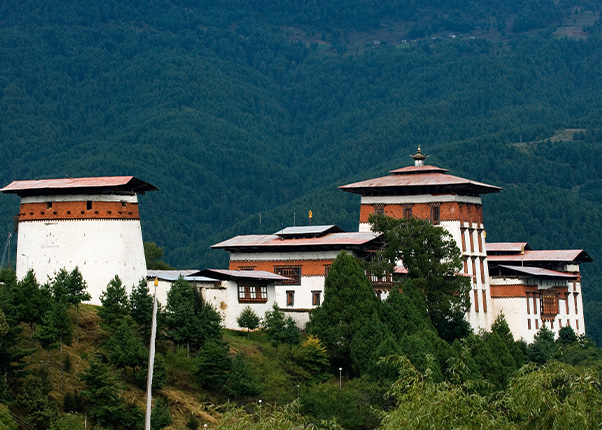
The Laya Gasa Trek is a breathtaking journey through Bhutan’s varied landscapes, encompassing lush farmlands, enchanting forests, alpine meadows, and lofty mountain passes. This epic trek takes you to some of the most spectacular campsites beneath Bhutan’s towering peaks while offering an intimate connection with the country’s pristine wilderness. Along the way, you’ll discover isolated cultural gems that add depth to your adventure.
Your voyage begins with a remarkable Druk Air flight over the Himalayas, providing a thrilling descent into the Kingdom of Bhutan. Upon your arrival in Paro, your expert guide will extend a warm welcome and ensure a seamless transition to your hotel. The quaint town of Paro invites you to explore its charm, with the night view of the Paro valley as a delightful backdrop.
Your adventure commences with a visit to Ta Dzong (National Museum), once a watchtower built in 1651 and later transformed into Bhutan’s National Museum in 1968. The museum houses a rich collection of antiques, including thangka paintings, textiles, weapons, Bhutan’s renowned postage stamps, coins, and handicrafts. Continue your morning journey with a tour of Rinpung Dzong (the fortress of the heap of jewels), a structure steeped in fascinating history. In the afternoon, venture to the ruins of Drukgyel Dzong, a site that witnessed Bhutanese victories over Tibetan invasions. You’ll also have the opportunity to experience the traditional lifestyle of indigenous people by visiting their homes. Conclude your day with a visit to Kyichu Lhakhang, one of Bhutan’s oldest and most sacred monasteries, followed by a peaceful return to your hotel.
Bid farewell to the road as you embark on the challenging trek from Drukgyel Dzong (2,580m). Your journey starts with a brief downhill stretch on a wide trail, followed by a gentle climb through well-maintained rice terraces, millet fields, and apple orchards. The route takes you deeper into the wilderness, eventually reaching the army post of Gunitsawa (2,810m), the final stop before Tibet. Continue the ascent to Sharma Zampa (2,870m), where you’ll find serene camping spots in meadows surrounded by trees.
As the first light graces the hilltops, your journey commences. The trail closely follows the Pa Chhu (Paro river), leading you through pine, oak, and spruce forests. After crossing a bridge to the river’s left bank, a hot lunch break awaits. The trail continues along the river, guiding you through rhododendron forests and across the river once more. At an altitude of 3,750m, you’ll arrive at your campsite, surrounded by the splendor of Bhutan’s natural beauty.
Your day kicks off early with a path that ascends to the army camp, presenting stunning views of the surrounding peaks. A hot lunch break will be hosted at a yak herder’s camp. A short walk into the valley leads you to the campsite at Jangothang (4,040m), where you can witness the majestic Chomolhari and Jichu Drake peaks.
The trail leads you through dwarf rhododendron trees and past Janetsho Lake. You’ll have the opportunity to encounter yak herders and gain insights into their way of life. Today’s journey is easy and pleasant as you pass through villages and yak herders’ camps. The campsite lies by a stream at an altitude of 3,860m.
After passing Lingshi Dzong, the trail proceeds through the hilltop, offering commanding views of green hills, winding roads, and majestic peaks. The Lingshi Dzong, also known as Yugyel Dzong, was constructed in the 17th century and played a vital role in controlling travel over Lingshi La (pass) between Tibet and Bhutan. Today’s trek is easy and pleasant, leading you through villages and yak herders’ camps. You’ll set up camp by a stream at an altitude of 3,860m.
The day begins with a rigorous climb to Gomby La pass at 4,450m, followed by a long descent to a stream at 4,170m. The trail then leads to a small ridge through a cedar forest, where a long climb over the ridge awaits. The trail finally descends on a muddy path into the main Jholethang valley, surrounded by fir and birch forests. In the afternoon, the trail traverses high above the valley floor, leading to Chachim, a yak pasture at 4,260m. The camp is set at 4,250m within a cluster of brush beside a stream at the valley’s bottom.
Start your day with a visit to Jambey Lhakhang, founded in the 7th century by Tibetan king Songtsen Gampo, who is considered to be the reincarnation of Jambey (Avalokitesvara), the Bodhisattva of Compassion.
Across the river, explore Tamshing Lhakhang, which contains fascinating old religious paintings. Drive to Punakha with lunch en route.
Overnight stay at a Punakha hotel.
Fill the form and we will be in touch.